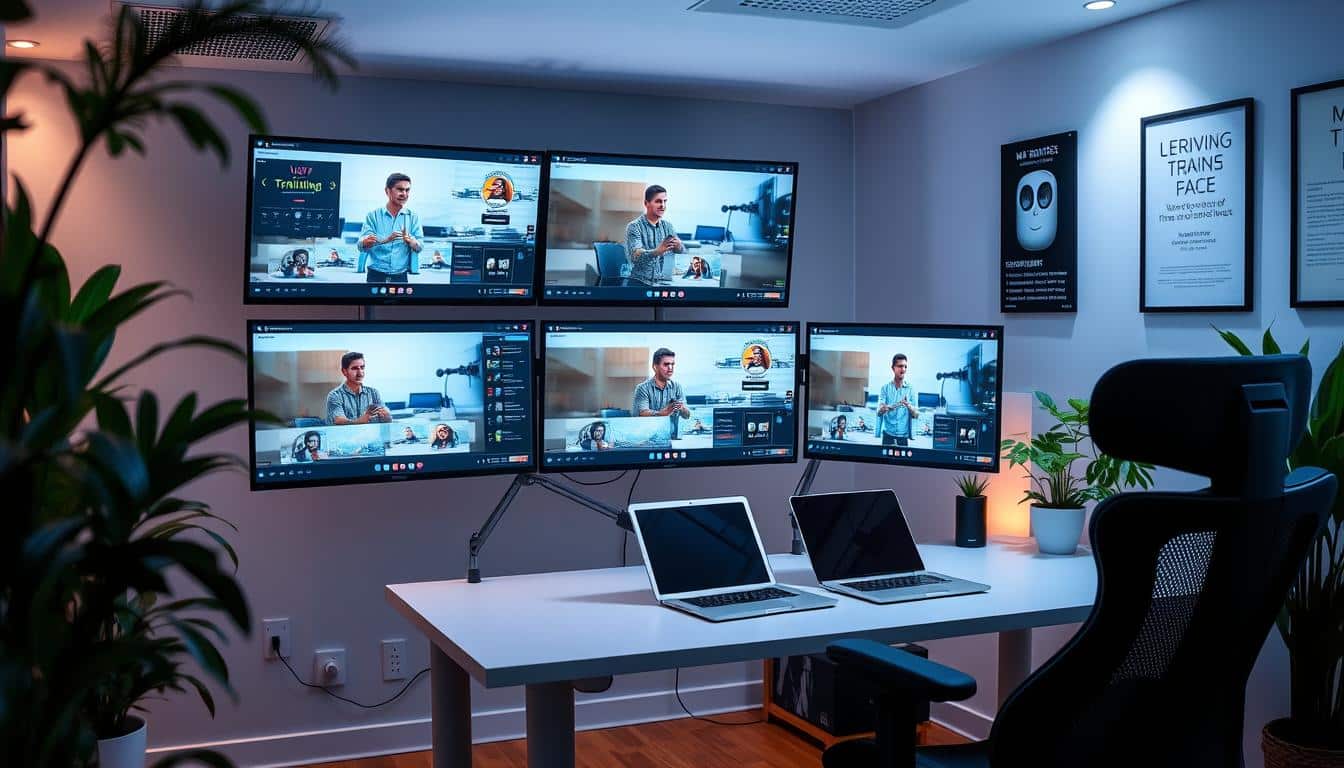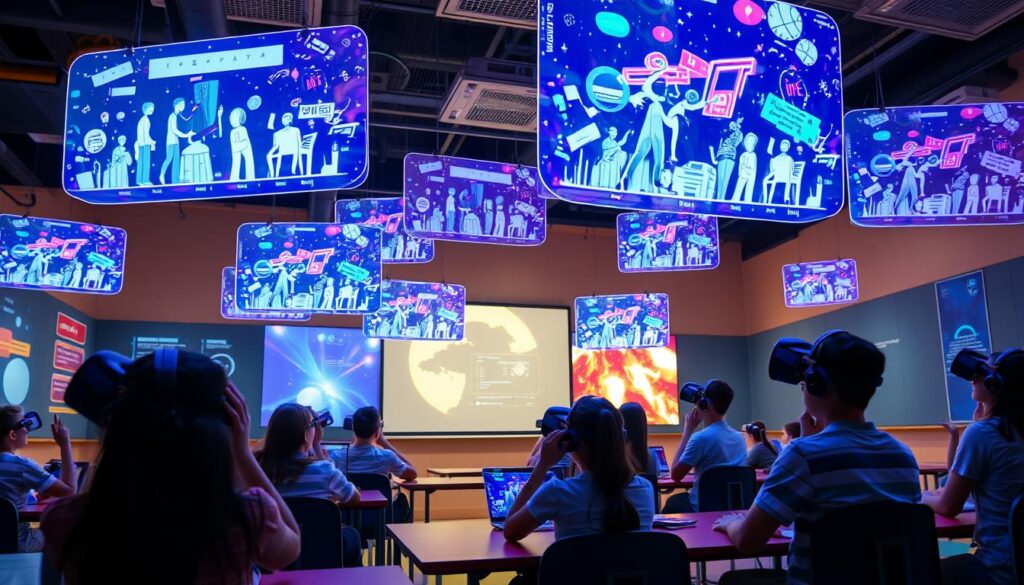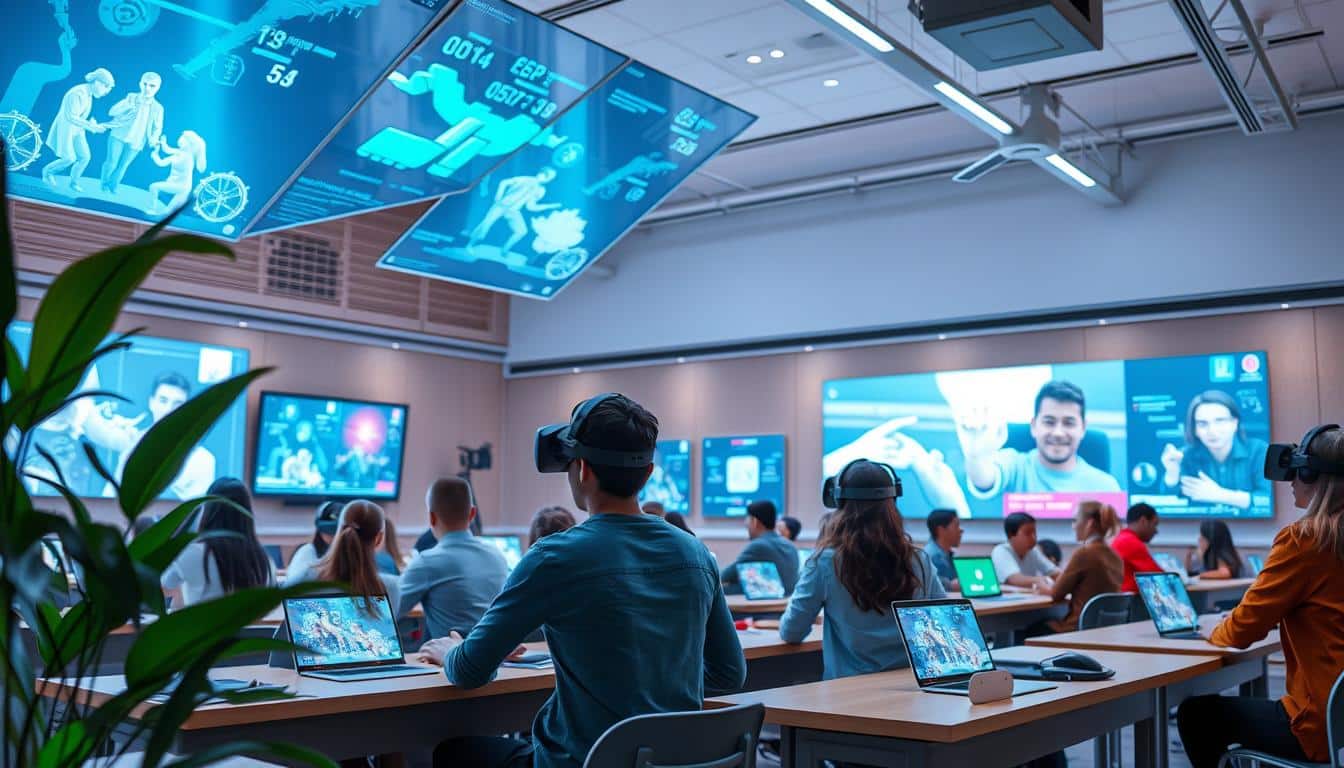The world of education is changing fast, thanks to new digital technologies. Online courses Embracing Digital Learning and virtual reality in classrooms are now common. This shift makes learning flexible and accessible from anywhere, anytime.
Online learning also helps break down barriers, reaching students worldwide. It opens doors for those who couldn’t access education before. The future of education will mix old and new ways, making learning exciting and inclusive.
Key Takeaways
- Online learning has experienced a surge in popularity, with a growth rate of 12% per year across universities and online platforms.
- The flexibility offered by digital learning is a crucial factor for 98% of students in pursuing online education.
- Universities offering online programs have observed a 25% increase in international student enrollment compared to traditional on-campus programs.
- Personalized learning features have significantly improved student engagement and performance by 85% according to educators.
- Institutions investing in virtual reality (VR) and augmented reality (AR) have seen a 30% increase in student retention rates.
The Rise of Online Learning
The COVID-19 pandemic made online learning a must for schools and students. Suddenly, classes moved to virtual classrooms. Old teaching ways were replaced by online platforms and tools. This big change brought many challenges but also brought technology into education faster.
Online learning gives students the freedom to learn anytime, anywhere. It’s great for those who need to work and study at the same time. It also helps students who like to learn at their own pace. Plus, it lets schools reach students all over the world, opening doors to education for many.
Flexibility and Accessibility
The growth of online learning is clear in the rise of digital learning platforms. These platforms have attracted a lot of money. For example, Udemy just got $50 Million in funding, showing how big online learning can get.
The pandemic made remote education more popular, with 75% of U.S. college students taking online classes in 2020. This change shows how online learning makes education more accessible and flexible for everyone.
| Key Online Learning Statistics | Value |
|---|---|
| Online Education Market Size | $350 Billion by 2025 |
| Udemy Funding Raised | $50 Million |
| U.S. College Students Taking Online Classes in Fall 2020 | 75% |
| iTunes U Downloads | Over 1 Billion |
| Stanford University Course Material Downloads | 40 Million |
“The COVID-19 pandemic significantly accelerated the adoption of online learning, with 75% of postsecondary students taking online classes in fall 2020.”
Personalized Learning Experiences

Education is changing fast, thanks to personalized learning. Adaptive learning technologies and data-driven analytics make online learning fit each student’s needs. This means learning is more effective and fun.
Teachers can see how students are doing and help where needed. This way, everyone learns at their own speed. It makes learning better and more fun for everyone.
New tech like virtual reality (VR) and augmented reality (AR) is exciting. It makes learning feel real and interactive. This tech can make online learning feel like being in a real classroom.
As we go on, learning will keep getting better. Personalized learning and new tech will help students do their best. They’ll be ready for a world that’s all about technology.
“Personalized learning leverages technology to optimize educational resources, accelerate student progress, and potentially reduce the overall duration of their learning journey.”
The Importance of Data-Driven Analytics
Data is key to making learning personal. Data-driven analytics help teachers see how students are doing. This lets them tailor lessons to each student’s needs.
- Identifying learning gaps and areas for improvement
- Customizing content and instructional approaches to individual needs
- Tracking student progress and adjusting learning paths accordingly
- Fostering student engagement and nurturing a love for learning
With data, learning can really help students succeed. It makes sure everyone has a chance to do well in school.
Challenges and Opportunities

The education system is moving towards digital learning, but it faces challenges and opportunities. The main issue is the digital divide, which makes it hard for everyone to get the same education. To fix this, governments, schools, and tech companies must work together to make sure everyone has equal access.
Keeping students interested in online learning is also a big challenge. Schools need new ways to make learning fun and interactive. Research shows that using computers can help some students, but it can also hurt others if the teacher isn’t good at using technology.
But, these problems also offer chances for growth and better learning. New tech and teaching methods can help solve issues like digital literacy disparities and cybersecurity risks. They can also help students stay connected and work together online.
Having change champions in schools can help teachers deal with new digital tools. Using the same tech, training teachers well, and having a library of content can make learning more consistent for everyone.
In the end, making digital learning work depends on tackling these challenges and using the opportunities to make education more inclusive, engaging, and secure.
| Challenge | Opportunity |
|---|---|
|
|
“The digital divide remains a persistent challenge, exacerbating existing inequalities in access to education and technology.”
Digital Learning

The digital revolution is changing education, bringing personalized learning, adaptive assessment, and immersive experiences to the forefront. Technology, including artificial intelligence, virtual reality, augmented reality, and blockchain, is transforming classrooms. This change is making teaching and learning more effective.
Artificial Intelligence (AI) leads this digital shift, making personalized learning pathways for each student. AI analyzes data to offer feedback and advice, helping students learn at their own speed. This way, they can reach their highest potential.
Virtual Reality (VR) and Augmented Reality (AR) create immersive learning experiences. They let students dive into complex topics in interactive, engaging ways. These tools can change how we learn about science, history, and the arts, making learning more fun and effective.
Blockchain technology promises to change how we handle educational records. It ensures these records are secure and can be easily shared. This makes the educational system more trustworthy and lets students take charge of their learning.
As these technologies grow, education will become more tailored, flexible, and engaging. By using digital learning, teachers can open new doors for student success. They will also prepare students for the 21st century’s challenges.
Also Read : The Impact Of Artificial Intelligence On Educational Technology
“The real revolution in education will come not from the technology itself but from the creative and thoughtful ways in which teachers use it.” – John Seely Brown, American scholar and former chief scientist at Xerox PARC
Conclusion
The world of education is changing fast with digital transformation and digital learning. It’s key for teachers, schools, and leaders to get on board. They need to invest in tech, train teachers well, and work together.
It’s also important to make learning accessible to everyone. This way, schools can help students succeed in a changing world. They can build a strong education system that supports lifelong learning and helps students grow in their careers.
Even with challenges, digital learning can change education for the better. It opens up new chances for growth for both students and teachers. By going digital, we can make education fairer and more open, helping learners reach their highest potential.
